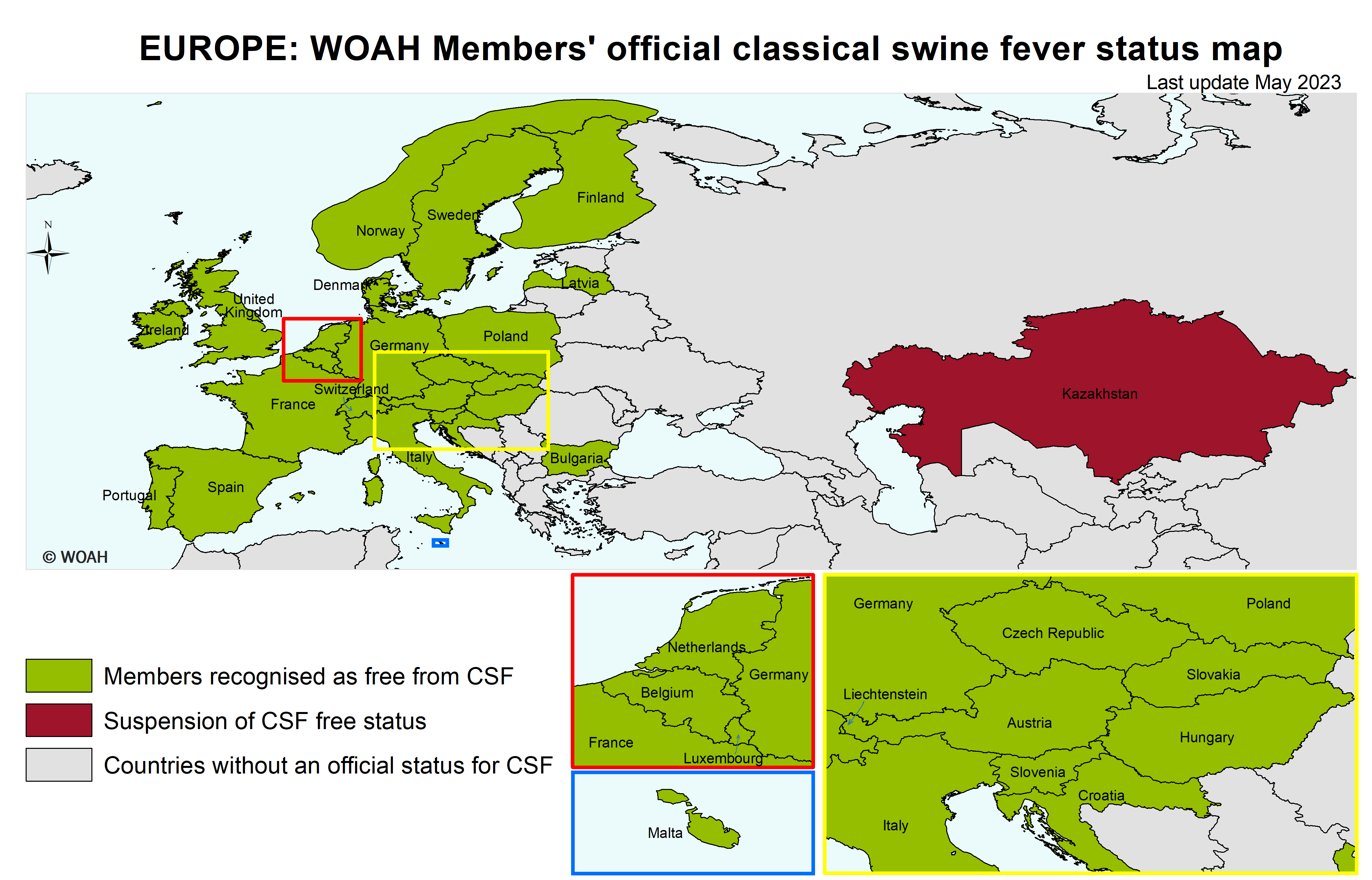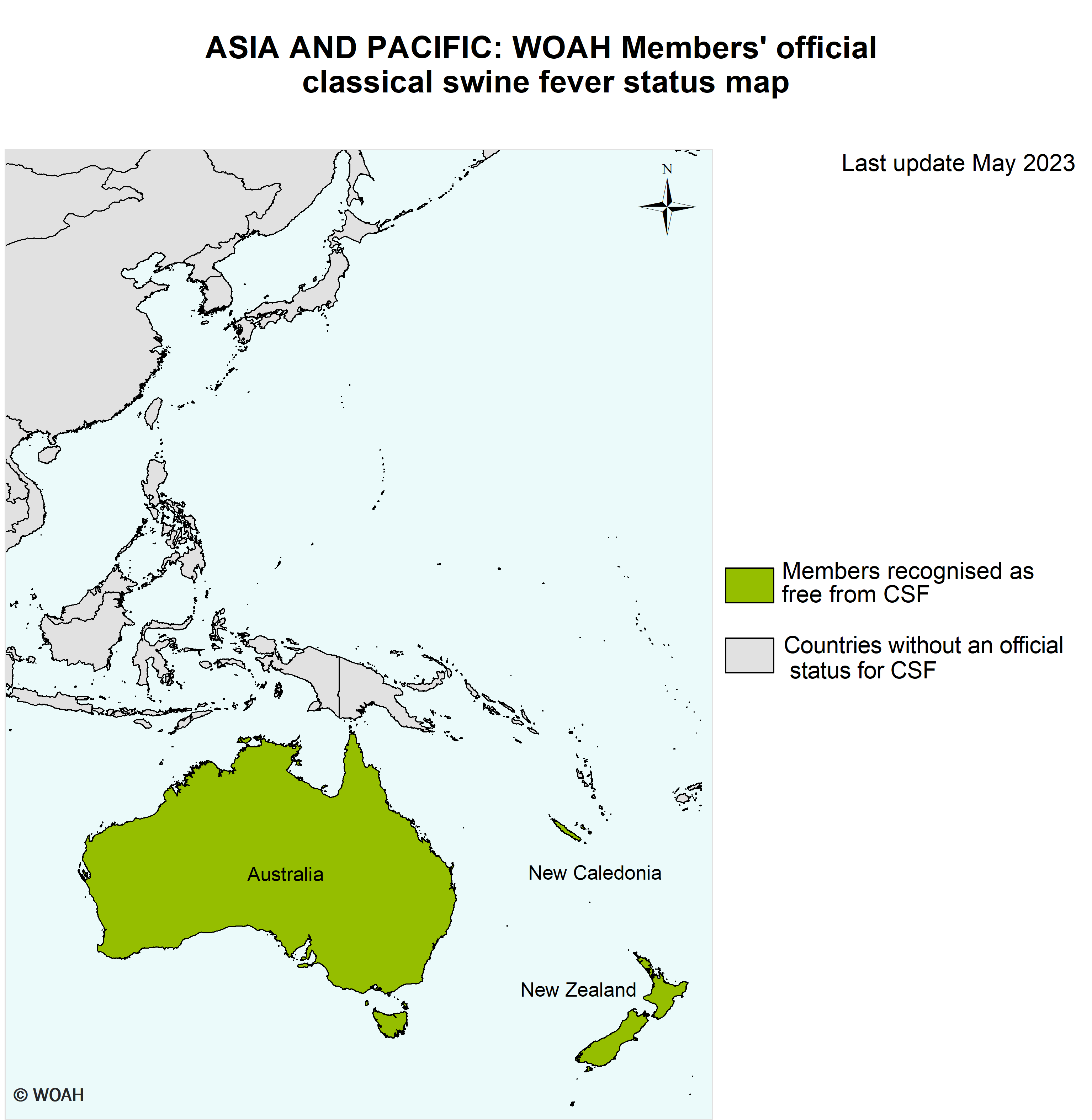Classical swine fever
Classical swine fever (CSF), also known as hog cholera, is a contagious viral disease of domestic and wild swine. It is caused by a virus of the genus Pestivirus of the family Flaviviridae. The most common method of transmission is through direct contact between healthy swine and those infected with CSF virus. CSF virus can survive in pork and processed pork products for months when meat is refrigerated and for years when it is frozen. Pigs can become infected by eating CSF-infected pork meat or products. Applying strict and rigorous sanitary prophylaxis, and hygiene measures protecting domestic pigs from contact with wild boar are the most effective measures to prevent the disease. When an outbreak occurs, slaughter of all pigs on affected farms with safe disposal of carcasses, bedding, etc. and surveillance of infected zone, and surrounding areas applied. In areas where the disease is endemic, vaccination can prevent the spread of the disease. In disease-free areas, a stamping out policy is applied consisting of early detection, movement control, proper disposal of carcasses, and cleaning and disinfection.
Links to Code and Manual
-
Terrestrial Code
-
Terrestrial Manual
What is Classical swine fever?
Classical swine fever (CSF), also known as hog cholera, is a contagious viral disease of domestic and wild swine. It is caused by a virus of the genus Pestivirus of the family Flaviviridae, which is closely related to the viruses that cause bovine viral diarrhoea in cattle and border disease in sheep. There is only one serotype of CSF virus (CSFV). CSF is a disease listed by the World Organisation for Animal Health (WOAH) Terrestrial Animal Health Code and must be reported to the WOAH (WOAH Terrestrial Animal Health Code).
Transmission and spread
The most common method of transmission is through direct contact between healthy swine and those infected with CSF virus. The virus is shed in saliva, nasal secretions, urine, and feces. Contact with contaminated vehicles, pens, feed, or clothing may spread the disease. Animals that are chronic carriers of the disease (persistently infected) may show no clinical signs of illness but may shed the virus in their feces. Offspring of infected sows can become infected in the uterus, and can shed the virus for months.
CSF virus can survive in pork and processed pork products for months when meat is refrigerated and for years when it is frozen. Pigs can become infected by eating CSF-infected pork meat or products.
It has been proven that in parts of Europe, the wild boar population may play a role in the epidemiology of the disease.
The disease has been spread through legal and illegal transport of animals, and by feeding swill containing infective tissues to pigs.
Public health risk
Humans are not affected by this virus. Swine are the only species known to be susceptible.
Clinical signs
The disease has acute and chronic forms, and can range from severe, with high mortality, to mild or even unapparent.
In the acute form of the disease, in all age groups, there is fever, huddling of sick animals, loss of appetite, dullness, weakness, conjunctivitis, constipation followed by diarrhoea, and an unsteady gait. Several days after the onset of clinical signs, the ears, abdomen and inner thighs may show a purple discoloration. Animals with acute disease die within 1-2 weeks. Severe cases of the disease appear very similar to African swine fever.
With low virulence strains, the only expression may be poor reproductive performance and the birth of piglets with neurologic defects such as congenital tremor.
Diagnostic
Because the clinical signs are not exclusive to CSF, and vary widely, laboratory tests are required to detect antibodies or the virus itself. The WOAH Manual of Diagnostic Tests and Vaccines describes the testing.
Prevention and control
Treatment is not attempted. Affected pigs must be slaughtered and the carcasses buried or incinerated.
The first barrier to prevent an outbreak of CSF is to apply strict and rigorous sanitary prophylaxis, as defined in the WOAH Terrestrial Animal Health Code. A good communication between veterinary authorities, veterinary practitioners and pig farmers, reliable disease reporting system, and hygiene measures protecting domestic pigs from contact with wild boar are the most effective measures to prevent the disease.
When an outbreak occurs, many actions must be set in place urgently:
- Slaughter of all pigs on affected farms
- Safe disposal of carcasses, bedding, etc.
- Thorough disinfection
- Designation of infected zone, with control of pig movements
- Detailed epidemiological investigation, with tracing of possible sources (up-stream) and
- Surveillance of infected zone, and surrounding area
In areas where the disease is endemic, vaccination can prevent the spread of the disease. Vaccines used should be produced in accordance with the WOAH standards for vaccine production. As the disease is brought under control, vaccination ceases, with continued surveillance. The WOAH Terrestrial Animal Health Code defines the requirements for a country or a zone to be considered free of the disease.
In disease-free areas, a stamping out policy is applied consisting of early detection, movement control, proper disposal of carcasses, and cleaning and disinfection. This policy has led to the elimination of CSF from North America, and much of Western Europe.
Geographical distribution
CSF is found in Central and South America, Europe, and Asia and parts of Africa. North America, Australia and New Zealand are currently free of the disease. In the 1990’s large CSF outbreaks occurred in The Netherlands (1997), Germany (1993-2000), Belgium (1990, 1993, 1994) and Italy (1995, 1996, 1997).
Regional activities
Americas
Europe
References
In accordance with the WOAH procedure for official recognition of disease status, this page provides access to the List of WOAH Members officially recognised free from classical swine fever (CSF) by the WOAH through the adoption of a resolution by the World Assembly of Delegates (Assembly) of the WOAH at the General Session in May every year.
A Member wishing to be officially recognised as disease-free by the WOAH should submit the questionnaire laid out in Chapter 1.6. of the WOAH Terrestrial Animal Health Code (Terrestrial Code) and comply with all requirements specified in the Terrestrial Code for CSF. The WOAH Scientific Commission for Animal Diseases (Scientific Commission) is responsible for undertaking, on behalf of the Assembly, the assessment of WOAH Members’ applications for their compliance with WOAH standards. The assessment carried out by the Scientific Commission is based on the recommendations formulated by a relevant ad hoc Group composed of world specialists in disease control.
-
Questionnaire
A_Questionnaire_CSF
.docx – 71 KB See the document
Subsequent to a disease outbreak or when the Scientific Commission determines that the conditions are not met anymore to demonstrate compliance with the relevant requirements of the Terrestrial Code, a disease status may be suspended. The Scientific Commission may decide to reinstate the suspended status when a Member has submitted an application which fulfils all the requirements requested for the recovery of official disease status laid out in the relevant Chapters of the Terrestrial Code. The suspensions and recoveries of disease status are announced by the Director General of the WOAH in consultation with the Scientific Commission and the list of these is kept up to date until adoption of a new resolution by the Assembly the following May.
Members with a disease free status officially recognised by the WOAH must submit an annual reconfirmation form by the end of November every year.
-
.docx – 73 KB See the document
Map of CSF official status
List of CSF free Members
CSF free Members
According to Resolution No. 18 (90th General Session, May 2023)
Members recognised as free from CSF according to the provisions of Chapter 15.2. of the Terrestrial Code :
| Argentina | Denmark | Luxembourg | Slovakia |
| Australia | Finland (1) | Malta | Slovenia |
| Austria | France (2) | Mexico | Spain (4) |
| Belgium | Germany | New Caledonia | Sweden |
| Bulgaria | Hungary | New Zealand | Switzerland |
| Canada | Ireland | Norway | The Netherlands |
| Chile | Italy | Paraguay | United Kingdom (5) |
| Costa Rica | Latvia | Poland | United States of America (6) |
| Croatia | Liechtenstein | Portugal (3) | Uruguay |
| Czech Republic |
(2) Including French Guiana, Guadeloupe, Martinique, Mayotte and Réunion.
(3) Including Azores and Madeira.
(4) Including Balearic Islands and Canary Islands.
(5) Including Guernsey (incl. Alderney and Sark), Isle of Man and Jersey.
(6) Including Guam, Puerto Rico and US Virgin Islands.
CSF free zone(7)
Members recognised as having a zone free from CSF according to the provisions of Chapter 15.2. of the Terrestrial Code :
Brazil: (Map):
+ one zone composed of the States of Rio Grande do Sul and Santa Catarina as designated by the Delegate of Brazil in a document addressed to the Director General in September 2014;
+ one zone covering the States of Acre, Bahia, Espírito Santo, Goiás, Mato Grosso, Mato Grosso do Sul, Minas Gerais, Rio de Janeiro, Rondônia, São Paulo, Sergipe and Tocantins, Distrito Federal, and the municipalities of Guajará, Boca do Acre, South of the municipality of Canutama and Southwest of the municipality of Lábrea in the State of Amazonas as designated by the Delegate of Brazil in a document addressed to the Director General in September 2015 and in October 2020;
+ one zone consisting of the State of Paraná as designated by the Delegate of Brazil in a document addressed to the Director General in October 2020;
Colombia: (Map)
+ one zone designated by the Delegate of Colombia in a document addressed to the Director General in September 2015.
+ the central-eastern zone as designated by the Delegate of Colombia in a document addressed to the Director General in October 2020;
Ecuador (Map)
+ one zone consisting of the insular territory of the Galápagos, as designated by the Delegate of Ecuador in a document addressed to the Director General in October 2018.
(7) For detailed information on the delimitation of the zones of the Members recognised as CSF free, enquiries should be addressed to the Director General of the WOAH.
Suspension/reinstatement of status
Suspension of a Member’s CSF free status
Kazakhstan
After careful consideration of information provided by the Delegate of Kazakhstan to the Scientific Commission for Animal Diseases to assess the country’s compliance with the Terrestrial Animal Health Code (Terrestrial Code) provisions for the maintenance of its CSF free status, the Scientific Commission concluded that Kazakhstan does not fully comply with the requirements of Article 15.2.3. of the Terrestrial Code. The “CSF free status” of Kazakhstan as recognised by the World Assembly of Delegates in terms of Resolution No. 18 in May 2022, is suspended with effect from 14 June 2022.




